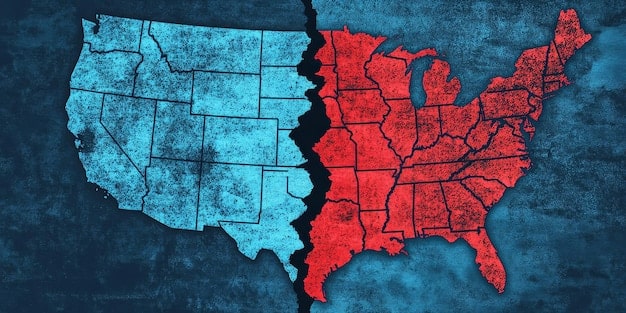The Impact of Gerrymandering: A State-by-State Analysis on Political Representation

The impact of gerrymandering on political representation across the United States is significant, leading to skewed electoral outcomes and reduced competitiveness in many states. This analysis explores these effects on a state-by-state basis.
The practice of redrawing electoral district boundaries to favor one political party over another, known as gerrymandering, has a profound and often detrimental effect on the fairness and competitiveness of elections. Understanding the impact of gerrymandering on political representation: a state-by-state analysis reveals stark disparities in how votes translate into seats and how effectively diverse communities are represented.
This article delves into the intricacies of gerrymandering, examining its historical roots, the methods used to create biased districts, and, most importantly, its consequences for political representation in various states across the US. How does this affect the choices we have in elections and the voice we have in government?
Understanding the Basics of Gerrymandering
Gerrymandering, in essence, is the strategic manipulation of electoral district boundaries to give an unfair advantage to one political party or group over another. This practice, deeply rooted in American political history, continues to shape the political landscape and affect the representational fairness of elections across the United States.
Historical Context and Evolution
The term “gerrymandering” dates back to 1812, when Massachusetts Governor Elbridge Gerry approved a districting map that contorted one district into the shape of a salamander. Ever since, the practice has evolved with increasingly sophisticated techniques, often leveraging advanced data analytics and mapping technologies.
Methods and Techniques Used in Gerrymandering
Gerrymandering employs several key techniques to achieve its biased outcomes. While these techniques are often masked within a legitimate process, the result is still the same: the impact of skewed elections.
- Cracking: Diluting the voting power of the opposing party by spreading its supporters across multiple districts.
- Packing: Concentrating the opposing party’s supporters into a single district to reduce their influence in other districts.
- Stacking: Merging minority-dominant districts with majority-dominant districts diminishes minority voting power.
Though subtle, these methods are a direct result of using politics in forming representation for citizens.

Gerrymandering is a contentious issue with significant implications for political representation. It can undermine the principle of “one person, one vote” and reduce the responsiveness of elected officials to the needs and preferences of their constituents.
The Impact of Gerrymandering on Political Representation: A State-by-State Analysis
When evaluating the impact of gerrymandering on political representation: a state-by-state analysis, it is essential to recognize that the effects can vary greatly depending on the state’s demographics, political dynamics, and legal framework. Gerrymandering can lead to several detrimental outcomes, including reduced competitiveness, disempowerment of minority voters, and increased political polarization.
States with a History of Gerrymandering
Several states have a long and well-documented history of gerrymandering, often resulting in districts that defy logical boundaries and bear little resemblance to compact, contiguous areas. These are states like North Carolina, Maryland, and Texas.
Examples of Egregious Gerrymandering
Specific examples of egregious gerrymandering can be found across the United States. While the reasons for these actions are varied, the end results tell a unified story of voters being misrepresented.
- North Carolina’s 12th Congressional District: Famously known for its serpentine shape, it was repeatedly challenged in court for racial gerrymandering.
- Maryland’s 3rd Congressional District: Described as one of the most gerrymandered districts in the nation, it snakes across the state, connecting disparate communities.
- Texas Congressional Districts: Several districts in Texas have been criticized for intentionally diluting the voting power of minority groups.
Gerrymandering is a contentious practice with considerable legal consequences. Courts have repeatedly intervened in cases of extreme gerrymandering, particularly when it violates constitutional principles of equal protection and voting rights.
Legal Challenges and Court Interventions
Legal battles over gerrymandering are common. It is important to note that there are several legal foundations to challenge gerrymandering. These range from constitutional principles to the Voting Rights Act. As such, courts will often intervene in the process and redistrict the locations.
The Role of the Supreme Court
The Supreme Court has played a crucial role in shaping the legal landscape of gerrymandering. While the Court has traditionally avoided ruling on partisan gerrymandering claims, it has been more active in cases involving racial gerrymandering.
Key Legal Precedents
Several landmark cases have established important legal precedents regarding gerrymandering. These cases offer a perspective on the legal landscape surrounding this practice as a whole.
- Baker v. Carr (1962): Established the principle of “one person, one vote” and opened the door for judicial review of redistricting plans.
- Shaw v. Reno (1993): Ruled that oddly shaped districts cannot be drawn solely to segregate voters by race.
- Evenwel v. Abbott (2016): Upheld the use of total population, rather than total voting population, in drawing legislative districts.

Despite legal challenges, gerrymandering remains a persistent issue in American politics. The lack of clear and consistent legal standards for partisan gerrymandering has made it difficult to achieve meaningful reforms through the courts.
Alternative Solutions and Reforms
Many reformers advocate for non-partisan redistricting commissions. These commissions can help create competitive districts. This results in better election results overall.
Independent Redistricting Commissions
Independent redistricting commissions are designed to remove the partisan influence from the redistricting process. These commissions typically consist of members from both major parties, as well as individuals with expertise in mapping, demographics, and political science.
Criteria for Fair Redistricting
To promote fairness and transparency in redistricting, several criteria should be considered when drawing district boundaries.
- Contiguity: Districts should consist of geographically connected areas.
- Compactness: Districts should be as compact as possible, avoiding irregular shapes.
- Respect for Political Subdivisions: Districts should respect existing political boundaries, such as county and city lines.
Reforms to the redistricting process, such as implementing independent commissions and adopting clear, objective criteria, are essential for promoting fairness and competitiveness in elections.
The Role of Technology and Data Analytics
How does technology impact gerrymandering and representation? Data and technology are useful tools, but also potentially dangerous when in the hands of partisan leadership.
Using Data to Predict Political Behavior
Parties can use data to determine who will vote in the future. Using this information, they can try to gerrymander districts to their benefit. These are complex algorithms that are changing the world of elections as more data becomes available.
AI and the Future of Gerrymandering
What will AI’s role be in districting? It is hard to predict but it is safe to assume that it will have a large impact. The algorithms that it produces can create efficient cracks and packs, something that will be a legal problem in the future.
While technology offers powerful tools for analyzing and visualizing electoral data, it also raises concerns about the potential for misuse. Safeguards are needed to ensure that technology is used responsibly and ethically in the redistricting process.
Conclusion
The impact of gerrymandering on political representation: a state-by-state analysis reveals a complex and multifaceted problem. While gerrymandering is difficult to identify, the impact it has on fair representation is measurable and should be addressed.
Ultimately, addressing the challenge of gerrymandering requires a multi-pronged approach, including legal reforms, independent redistricting commissions, and increased public awareness. By working together, we can strive for a fairer, more representative democracy.
| Key Point | Brief Description |
|---|---|
| 🗳️ Gerrymandering | Manipulating district boundaries to favor a party. |
| ⚖️ Legal Challenges | Courts intervene in cases of extreme gerrymandering. |
| 🤝 Independent Commissions | Remove partisan influence from redistricting. |
| 📊 Technology Role | Data and AI can impact districting outcomes. |
Frequently Asked Questions
Gerrymandering is the practice of manipulating electoral district boundaries to favor one party over another, leading to reduced competition and skewed representation. This is the impact of gerrymandering on political representation: a state-by-state analysis.
The responsibility for drawing congressional districts typically falls to state legislatures. In some states, independent commissions handle the redistricting process to minimize partisan influence.
Legal challenges to gerrymandering often center on claims that the redrawn districts violate the principle of “one person, one vote” or discriminate against minority voters. This directly violates the impact of gerrymandering on political representation: a state-by-state analysis.
Many states are looking into independent commissions to prevent gerrymandering. The commissions take out the party politics involved in making the districts and allow them to be more fair to the people who they represent.
By looking at each state individually, we can identify the ones that have the most extreme cases of district skewing. We can study these states and find what can be improved about the process.
Conclusion
The analysis of the impact of gerrymandering on political representation: a state-by-state analysis brings the issue back to the question of the value of having fair representation in various democratic societies. By implementing fair practices, we can bring democracy back to the people.
Overall, the redistricting process is complex and very involved, but should allow for more representation through citizens’ votes and thoughts, allowing the voices of all to be heard and brought to the forefront.





